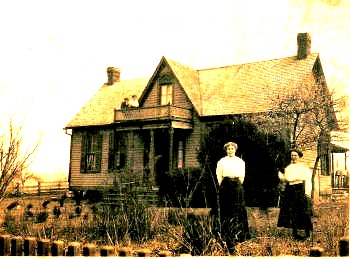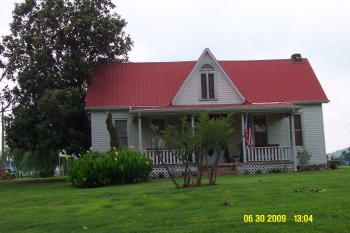John was born on May 21st, 1928 at his
family's home in Murray County, GA. He was the sixth
child of Albert Taylor Rymer and Frances McCamy
Rymer. He had an older brother and four older
sisters. For more on his early life see
John's Story from birth to
high school and
From High School
through the Air Force.
While on leave from the Air Force, (before going
overseas) John met Beverly Ann Staples in Fort
Lauderdale, Florida on a blind date. He was sold on
getting a date with her when she was described as;
"Short and dumpy, but she sure is cute." On his first
date he found the description was accurate but should
have included, " and fun to be with". Beverly and
John corresponded while John was overseas, on his return
and discharge in October. 1954 they dated and became
engaged at Christmas, being married on April 11th, 1955
in the First Presbyterian Church in Fort Lauderdale.
Beverly and John had three children:
John Taylor Rymer on August 31, 1956
Todd McCamy Rymer on August 5, 1957
Ann Elizabeth Rymer Brady on October 16, 1962
More about them later.
Beverly's parents were; James Gwyn Staples Jr. and
Caroline Taylor Staples who lived in Fort Lauderdale,
FL.
Beverly's father died in 1955, shortly before she was
married and is buried in the Fort Lauderdale memorial
cemetery. His parents (Beverly's grandparents) Were Dr.
James Gwyn Staples and Kate Collins Staples of
Demopolis, AL. James and Kate were divorced and
James married again, he and his second wife also had one
son.
Beverly's mother, Caroline Taylor Staples parents were;
Jamie and Myra Newton Taylor. They also lived in
Demopolis, AL. where Jamie was a banker and enjoyed
harness racing (Have no idea if he was good). Beverly's
grandmother, Myra Newton Taylor was an exceeding
brilliant person, as was her brother: Oscar
Newton
Click here,For more info on Oscar who became head
of the Federal Reserve Bank in Atlanta (he also had a
pullman railroad car named after him).
While we are unsure (have forgotten) of the exact
relationship, Beverly's grandmother spoke about Rev.
George Newton as one of her forefathers. He was was a
Presbyterian Minster in the Asheville, NC area during
the early 1800's, founding both a church and school.
Today there are two historical markers about his work on
Merriman Avenue in Asheville. The following is copied
form the website "unca.edc"
"In
1793, on land owned by William Forster, II, a school
to be known as Union Hill was organized
by Robert Henry, a versatile and well-educated man
who had recently come into the
Buncombe area along with many other pioneers*
Veterans of the Revolution. People:
in the area yearned for spiritual and educational
opportunities, and in 1793 on a
knoll covered with magnificent oaks and pines,
Robert Henry and his patrons erected a log school
building, the first one in the State west of the
Blue Ridge/fountains. Both boys and girls attended
the school coming on horseback from the various
farming communities to take advantage of "book
learning'1 offered by Mr. Henry at
Union Hill. In 1797, Robert Henry resigned, as head
of Union Hill to begin the practice
of law. It was then that George Newton, age 32, and
recently arrived from Rutherford County to
become educational leader of the newly formed
village of Asheville, and was appointed
teacher of Union Hill to succeed Mr. Henry. Almost
at once Mr. Newton received a call
from three congregationsóBee Tree, Swannanoa
(Asheville) and Reems Creek to serve them
as minister. Thus, George Newton began a residence
of seventeen years in the Asheville area as its
teacher and minister. His service seemed
to please these predominantly Presbyterian people
who demanded educated ministers and a
church-centered education for their children. Under
George Newton's leadership this two-fold service was
reflected in every phase of community life. He was
an outstanding teacher with a
rich background of information with the ability to
impart his knowledge and to inspire
his pupils. Under his leadership, Union Hill became
a Boys' School and in 1805, by
an act of Legislature, it became Union Hill Academy.
Four years later, in 1809, this name was changed to
Newton Academy honoring the highly-esteemed
teacher-minister, George Newton. The influence of
George Newton reached far
beyond the confines of Newton Academy. Many of his
pupils became leaders in shaping the development of
the town, county, State, and Nation. Among these men
are
the names of David Lowry Swain, President of
the University at Chapel Hill and later Governor
of the State, B. F. Perry, ,who became Governor of
South Carolina, Gen. Robert B.
Vance ó many native Ashevillians recall stories told
by the parents or anancestor who attended
Newton Academy School."
'
Back

